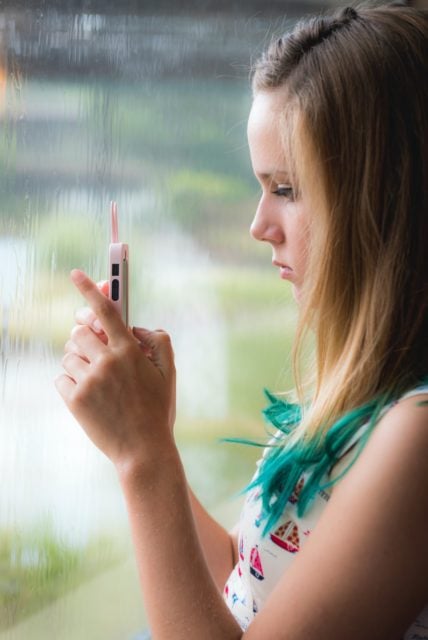Among the many difficult decisions that families undertake, choosing the right high school can be one of the most stressful. The vast array of options and the pressure to make perfect educational decisions can cause confusion and self-doubt. In particular, many parents struggle to balance the wants and needs of their child with their perspective on how four crucial years of education should be spent.
Amanda Morales Pirela and her parents recently experienced firsthand the complexity of making the high school decision. Amanda, now a 9th-grader at a creative arts school in Minnesota, had attended school in her home district since Kindergarten, and she had always assumed she would graduate from the local public high school. Amanda’s family believes deeply in public education and has strong ties in the district, with her younger brother attending school there and her mother, Mary, working as a District Wide Interpreter-Translator, a position she has held for many years.
But as Amanda settled into her last year of middle school, she felt something was missing. While her grades were impeccable, and she had a solid group of friends, she felt bored and frustrated. While her friends seemed happy to be at school, Amanda dreaded going and felt that her mental health was suffering. She couldn’t see herself spending another four years doing the same thing.
Mary and Amanda’s dad, Carlos, noticed a change in their usually bubbly daughter and attributed it to more than typical adolescent moodiness. In particular, they noticed that Sunday evenings and Monday mornings were especially hard, as Amanda consistently complained that she didn’t want to return to school after the weekend. “She seemed sad, sick, and anxious,” says Mary. “She wanted to do more than what she was doing.”
So when Mary and Carlos heard about a creative arts high school in a neighboring community, they thought it might be a good fit for their daughter. “Amanda has always been very artistic and doing that makes her happy. We offered the opportunity and showed her we thought the school would be great for her.”
While her parents initially presented the creative arts school option, Amanda confirms that they ultimately left the decision to attend it up to her. “We have communication and they understand that I’m a teenager,” says Amanda. “I need to have a say in certain things, especially if they concern me. Like going to school or doing something I don’t want to do.”
Parenting and adolescent research support Amanda’s parents’ approach regarding her high school decision. In their book, The Self-Driven Child, Stixrud and Johnson state that “without a healthy sense of control, kids feel powerless and overwhelmed and will often become passive or resigned.” They say that children and adolescents who are denied the ability to make meaningful choices will experience increased anxiety, difficulty managing anger, and self-destructive tendencies.
It would be difficult to identify a more “meaningful choice” facing a young teenager than where to spend their high school years. So when parents decide about high school FOR their teen, it can seriously backfire. While they may attend a rigorous school designed to prepare them for a great college, the teen who doesn’t want to be there is less likely to feel invested and motivated and, subsequently, less likely to work hard and perform well. The same can be said for a teen sent to a parent’s alma mater without consideration of whether it’s the best fit for that child. In contrast, a teen who attends the school of their choice is more likely to buy in and have the built-in motivation to work hard and achieve their full potential.
“I think communication is really important between parents and a child,” advises Amanda. “The parents should remember that their child will be going through this, not them. The kid should go to the school they want, that will make them feel safe and happier, and give them the most opportunity to grow.”
Mary agrees. “For them, it’s hard to be in an environment where they don’t feel safe, heard, motivated, and growing,” she says. “If they are not feeling that, I don’t see a way for them to succeed.”
There are, of course, potential pitfalls to allowing adolescents to make independent decisions that can have significant consequences for the future since teens often behave impulsively and have questionable priorities. That’s why child development experts recommend taking an authoritative, supportive approach to such decisions. (Levine, Steinberg).
In this approach, parents and their teens cooperate in making decisions. Parents emphasize self-direction and encourage the child to think through their options while providing support. Authoritative parents enforce limits and state when something doesn’t feel right. As a result, the teen feels less compelled to fight their parents and more inclined to work with them to reach a favorable decision.
Amanda’s parents found that the authoritative style worked well in their decision-making process, and Mary states that they will continue to use it. When asked what she would do if Amanda wanted to switch schools again, she answered, “We’ll support her and try to find a solution to what is making her change her mind. Sometimes she likes an easy solution, and we need to work through that. If we can work on finding the right solution for her, we will do it. And if it’s going to a different school, that’s what it will be.”
But right now, Amanda has no intention of making any changes. She reports that things are going very well at her new school. “I feel a lot happier and more upbeat. I feel excited to go to school and learn, and I feel like I’m getting more confident in myself and putting myself out there. I’m still working on it, but it feels more like I can be myself.”
What better result could a parent hope for?
 Angie McIntyre, Clear Trails Youth Coaching Angie is a Certified Youth Resilience Coach and Licensed School Psychologist based in the Twin Cities Metro Area. Angie provides virtual and in-person life coaching services to young people ages 13-25, and family coaching to caregivers of children ages 10-13. You can learn more at www.ClearTrails.net email her at [email protected]
Angie McIntyre, Clear Trails Youth Coaching Angie is a Certified Youth Resilience Coach and Licensed School Psychologist based in the Twin Cities Metro Area. Angie provides virtual and in-person life coaching services to young people ages 13-25, and family coaching to caregivers of children ages 10-13. You can learn more at www.ClearTrails.net email her at [email protected]Source:
Stixrud, William & Johnson, Ned. The self-driven child: The science and sense of giving your kids more control over their lives. Penguin Books, 2018.





















